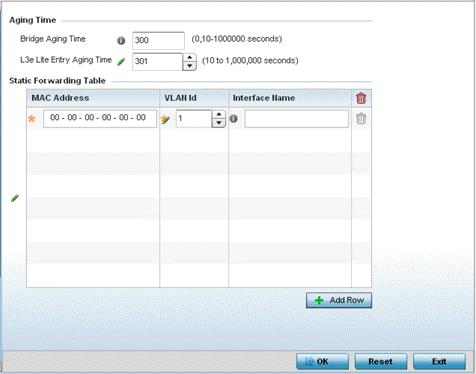A Forwarding Database is used to forward or filter packets on behalf of a controller, service platform or access point. The packet's destination MAC address is read and the controller, service platform or access point decides to either forward the packet or drop (filter) it. If it is determined the destination MAC is on a different network segment, it forwards the packet to the segment. If the destination MAC is on the same network segment, the packet is dropped (filtered). As nodes transmit packets through the bridge, the bridge updates its forwarding database with known MAC addresses and their locations on the network. This information is then used to filter or forward the packet.
To define a forwarding database configuration:
Select Configuration > Profiles > Network.
Expand the Network menu to display its submenu options.
Select Forwarding Database.

Define a Bridge Aging Time between 0, 10-1,000,000 seconds.
The aging time defines the length of time an entry remains in the a bridge's forwarding table before being deleted due to inactivity. If an entry replenishments a destination generating continuous traffic, this timeout value will never be invoked. However, if the destination becomes idle, the timeout value represents the length of time that must be exceeded before an entry is deleted from the forwarding table. The default setting is 300 seconds.
Define a L3e Lite Entry Aging Time between 10-1,000,000 seconds.
The default setting is 300 seconds.
Use the +Add Row button to create a new row within the MAC address table.
Set a destination MAC Address address. The bridge reads the packet's destination MAC address and decides to forward the packet or drop (filter) it. If it's determined the destination MAC is on a different network, it forwards the packet to the segment. If the destination MAC is on the same network segment, the packet is dropped (filtered).
Define the target VLAN ID if the destination MAC is on a different network segment.
Provide an Interface Name used as the target destination interface for the target MAC address.
Select OK to save the changes. Select Reset to revert to the last saved configuration.

 Print
this page
Print
this page Email this topic
Email this topic Feedback
Feedback